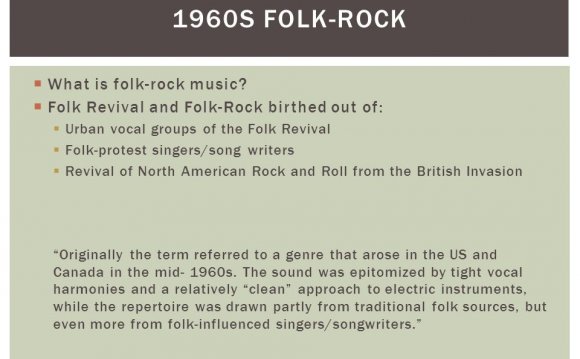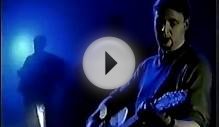
The Roots of Folk Rock
Folk rock arose mainly from the confluence of three elements:
- urban/collegiate folk groups
- singer-songwriters
Folk groups and sing-songwriters often were inspired by earlier "folk" pioneers such Woody Guthrie, Pete Seeger and other songsters of the labor movement of the 1930s and 1940s. The first of the urban folk vocal groups was the Almanac Singers, whose shifting membership included Guthrie, Seeger and Lee Hayes. In 1947 Seeger and Hayes joined Ronnie Gilbert and Fred Hellerman to form the Weavers, who popularized the genre and had a major hit with a cover of Leadbelly's "Irene, " but fell afoul of the U.S. Red Scare of the early 1950s. Their sound, and their broad repertoire of traditional folk material and topical songs inspired other groups such as the Kingston Trio (founded 1957), the Chad Mitchell Trio, New Christy Minstrels, the Brothers Four, the Four Freshmen, and the Highwaymen. All featured tight vocal harmonies and a repertoire at least initially rooted in folk music and (often) topical songs. Individual performers such as Ramblin' Jack Elliott, Dave Van Ronk, Judy Collins, Odetta, and Joan Baez also helped lay the foundations of the folk music revival. Singer-songwriters such as Bob Dylan and Phil Ochs gained popularity in the mid 1960s.
Yet, as writer Richie Unterberger observes:
In the early 1960s, any suggestion that the folk and rock'n'roll worlds would intertwine to create a hybrid called folk-rock would have met with utter disbelief from both camps. The folk community prided itself on its purity, which meant acoustic instruments and songs of substance; it regarded rock'n'roll as vulgar and commercial. Rock'n'rollers, for the most part, were utterly ignorant of folk traditions, and unconcerned with broadening their lyrical content beyond tried-and-true themes of romance and youthful partying.[1]
Folk Rock Hits the Charts
Folk music occasionally reached the pop charts in the late 1950s and early 1960s. The Kingston Trio had scored a major hit with "Tom Dooley" in 1958 and the Tokens reached number one in 1961 with "The Lion Sleeps Tonight." Peter, Paul, and Mary did much to popularize Bob Dylan as a songwriter when they covered his song, "Blowing in the Wind" in 1963. However, the folk genre might never have intersected with rock music if it had not been for the impulse of the British Invasion. Songs such as "House of the Rising Sun" by Eric Burdon and the Animals (1964), "I'm A Loser" by the Beatles (1965), and "Get Together" by the We Five (1965) have been cited as important precursors to the folk-rock trend. The 1964 hit "I Know I'll Never Find Another You" by the Australian group the Seekers could also be mentioned. However, The Byrds' cover of Dylan's "Mr. Tambourine Man, " was the true trend-setter when it reached the top of the charts in April, 1965.
Bob Dylan's folk rock album, Blonde on BlondeDylan himself went electric, much to the horror of folk purists, in 1965 with his Bringing It All Back Home and Highway 61 Revisited albums. Dylan's "Like A Rolling Stone" became the unofficial anthem of the searching generation of the mid-late 1960s. Unlike other folk rock performers, much of Dylan's music during this period was also heavily blues influenced.
RELATED VIDEO












